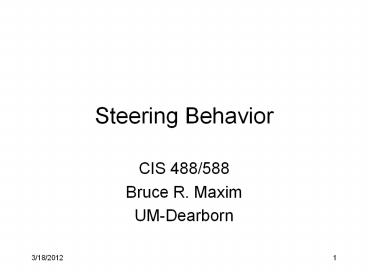Steering Behavior - PowerPoint PPT Presentation
1 / 17
Title:
Steering Behavior
Description:
Certain retailers have always had a greater focus than others ... Growing concern about provenance of product. Bigger issue in the UK than anywhere else ... – PowerPoint PPT presentation
Number of Views:40
Avg rating:3.0/5.0
Title: Steering Behavior
1
Steering Behavior
- CIS 488/588
- Bruce R. Maxim
- UM-Dearborn
2
Alife
- Focuses on behavior of individual creatures that
combine into complex pattern - The interaction of simple patterns can create
incredibly sophisticated simulations - Alife can be used to simulate crowds in complex
environments using streering behaviors - This was the basis of Conways game of life
3
Assumptions
- Steering behaviors assume the existence of a
lower-level of the engine to handle locomotion - The locomotion system processes each characters
position and velocity - When player stops pressing a key movement stops
(heavy duty friction) - In many games a key press is likely to control
velocity and not acceleration - In this chapter velocity persists and the AI
applies an acceleration to effect steering
4
Seeking and Fleeing
- Seeking
- Steering behavior moving creatures toward target
- Fleeing
- Steering behavior moving creatures away from
target - Pursuit
- Seeking a moving target
- Evasion
- Avoiding a moving target
5
Enhancements - 1
- Wandering
- Make random behavior appear a little more
purposeful - Patterns should be slightly unpredictable, but
not arbitrarily random - Could accumulate steering values and filter them
using the sin function (gives both and
values) - Projecting Targets
- Look ahead randomly for point where target is
predicted to be and move there
6
Seeking Implementation
- compute velocity vector toward target
- desired_velocity truncate(position_target,max_sp
eed) - compute steering force
- steering_force desired_velocity -
velocity - Arrival behavior can be simulated by slowing down
the velocity to something less than max_speed
within some distance from target
7
Fleeing Implementation
- // compute velocity vector toward target
- desired_velocity truncate(position_target,max_sp
eed) - // compute steering force
- steering_force - desired_velocity -
velocity
8
Modeling Flocks
- There are additional steering components needed
(e.g. alignment and cohesion) when modeling group
behaviors - These require position and orientation
information for neighbors rather than surrounding
obstacles
9
Generalized Obstacle Avoidance
- function avoid_obstacles
- project future position based on velocity
- if collision predicted
- project empty position away from collision
- compute turn to get to empty position
- if obstacle is within critical distance
- determine braking force // slow or stop
- apply steering and braking forces
10
Comments
- Application of steering and braking forces is
easy since our interface outputs turn and move
values - The challenge is in acquiring the inputs used to
determine future collisions - This algorithm requires environment knowledge,
intersection tests, collision normal forces, and
location of nearby empty spaces - This makes it unsuitable for implementation
11
Updated Obstacle Avoidance - 1
- function avoid_obstacles2
- check sensors for free space front, left, right
- if front collision predicted
- find furthest obstacle on right or left
- determine best side to turn toward
- compute turn to seek that free space
- if front obstacle is within critical distance
- determine braking force // slow or stop
12
Updated Obstacle Avoidance - 2
- if obstacle on left
- adjust steering to step right
- if obstacle on right
- adjust steering to step left
- apply steering and braking forces
- Implementing this involves simple translation to
C and finding suitable parameters during
experimentation phase
13
Enhancements - 2
- Forced Exploration
- Keep track of previous positions a flee from them
- Done using single vector (provenance)pointing
toward last position - Coefficients a b 1
- provenance a previous
- b provenance
14
Advantages - 1
- Simplicity
- Hard to find a simpler architecture
- Reliability
- Most situations can be identified requirements
- Predictability
- No ambiguity, each rule written explicitly
- Efficiency
- Very low computational overhead
15
Disadvantages - 1
- Local traps
- Can still get stuck in corners, if it begins to
turn one way and then decides the another way
might be better - Testing
- This approach requires extensive testing because
there are so many parameters to play with
16
Disadvantages - 2
- Realism
- Robotic movement is not as smooth as it might be
(local decisions are not integrated into a plan) - Scalability
- Additional behaviors are added by adding
additional lines of code and recompiling
17
Marvin
- Uses obstacle sensors and steering behaviors to
prevent collisions in a reactive fashion - Uses chapter enhancements to improve its
wandering behavior































